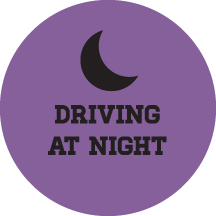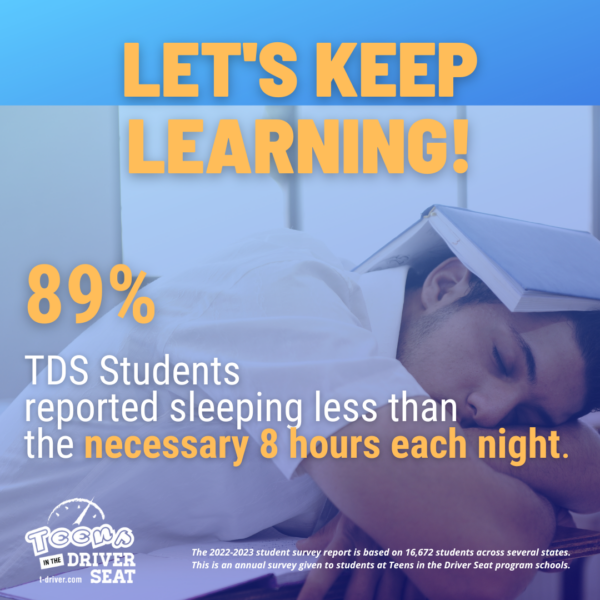 Combined with limited visibility and drowsiness driving at night is dangerous, especially for teens.
Combined with limited visibility and drowsiness driving at night is dangerous, especially for teens.
Sixty-two percent (62%) of teen crash deaths occur between 6 pm and 6 am.1 As reported by a 2010 study by Texas A&M Transportation Institute, this is primarily due to a combination of the visibility challenges caused by dark conditions, slower response time brought about by fatigue, and a lack of experience driving under such conditions. It is largely for these reasons that most states include a nighttime driving restriction in Graduated Driver License (GDL) laws. In most states with a GDL law, the nighttime restriction and a limit on the number of passengers allowed are the most widely implemented features of that law.
The problem of visibility:
- The average person’s field of vision is smaller without the aid of light, and glare from oncoming headlights can further limit the ability to see clearly and to avoid hazards.
- High-Intensity lights are becoming more common. These lights are brighter to oncoming traffic and require your eyes to adjust faster.
- It is more difficult to judge other vehicles’ speeds and distances at night.
- Dusk can be a dangerous time to drive because there’s typically a lot of congestion and your eyes are constantly having to adjust to more darkness.
- Rural roadways can be especially dangerous at night due to higher numbers of unlit roadways. The number of urban fatalities has been larger than the number of rural fatalities since 2016.2
What to do about poor visibility:
- As always, wear your seat belt. The danger of driving at night should not be multiplied by being unsecured.
- Keep distractions to a minimum to keep your eyes and attention on the road.
- Turn headlights on at dusk and observe night driving safety as soon as the sun goes down.3
- Reduce your speed and increase your following distances. Don’t overdrive your headlights. You should be able to stop inside the illuminated area. If you can’t, you are creating a blind crash area in front of your vehicle.3
- Keep your headlights and windshield clean. A thin film of debris on your headlights can reduce your visibility significantly.3
- If an oncoming vehicle’s lights are too high, avoid glare by watching the right edge of the road and using it as a steering guide.3
- Have your headlights properly aimed. Misaimed headlights blind other drivers and reduce your ability to see the road.3
The problem of drowsy driving:
- A study done by the AAA Foundation found that a person is more at risk for a crash the less sleep they get. A person is 12x more likely to crash if they have less than 4 hours of sleep at night.4
- Research suggests that teens should have 8 to 10 hours of sleep each night. Most teens do not get enough sleep — one study found that only 15% reported sleeping 8 1/2 hours on school nights.5
- Young drivers have a higher risk of falling asleep behind the wheel.5
- Sleepiness or fatigue causes the following:5
- Impaired reaction time, judgment, and vision
- Problems with information processing and short-term memory
- Decreased performance, vigilance, and motivation
- Increased moodiness and aggressive behaviors
- Individuals who snored or slept 6 hours or less per day were more likely to fall asleep while driving.6
 In the most recent TDS teen annual survey 89% of students surveyed reported getting less than 9 hours of sleep at night on average.7
In the most recent TDS teen annual survey 89% of students surveyed reported getting less than 9 hours of sleep at night on average.7- A recent survey found that teens report being “reluctant to miss out” and have an “always-on lifestyle” that can contribute to drowsy driving as they are getting less than six hours of sleep each night.8
- 70% of teens surveyed admitted to driving tired
- 50% reported actually falling asleep or nearly falling asleep at the wheel citing:
- A busy schedule: 43%
- Staying up late to do homework: 32%
- Staying up late for social activities: 24%
- Working late hours during the week: 20%
- Being tired or hung over from drinking/partying the night before: 10%
What to do about drowsy driving:
- Here are some signs of being tired and it’s time to pull over:9
- Difficulty focusing, frequent blinking, and/or heavy eyelids
- Difficulty keeping daydreams at bay
- Trouble keeping your head up
- Drifting from your lane, swerving, tailgating, and/or hitting rumble strips
- Inability to clearly remember the last few miles driven
- Missing exits or traffic signs
- Yawning repeatedly
- Feeling restless, irritable, or aggressive
-
- Before you drive, consider whether you are:9
-
Sleep-deprived or fatigued (6 hours of sleep or less triples your risk)
-
Suffering from sleep loss (insomnia) or poor quality sleep
-
Driving long distances without proper rest breaks
-
Driving through the night or when you would normally be asleep
-
Taking medications that make you tired (cold tablets, antihistamines)
- Studying a lot or attending more activities than usual, which may be decreasing your sleep time
-
Drinking even small amounts of alcohol
- Driving alone or on a long, rural, dark, or boring road
-
- Before you drive, consider whether you are:9
-
- What you can do to prevent falling asleep while driving:9
- Get a good night’s sleep before you hit the road. You’ll want to be alert for the drive, so be sure to get adequate sleep the night before you go
- Don’t be too rushed to arrive at your destination. Many drivers try to maximize the holiday weekend by driving at night or without stopping for breaks
- It’s better to allow the time to drive alert and arrive alive
- Use the buddy system. Just as you should not swim alone, avoid driving alone for long distances. A buddy who remains awake for the journey can take a turn behind the wheel and help identify the warning signs of fatigue
- Take a break every 100 miles or 2 hours. Do something to refresh yourself like getting a snack, switching drivers, or going for a run
- Take a nap—find a safe place to take a 15 to 20-minute nap, if you think you might fall asleep. Be cautious about excessive drowsiness after waking up
- Avoid alcohol and medications that cause drowsiness as a side-effect
- Avoid driving at times when you would normally be asleep
- Consume caffeine. The equivalent of two cups of coffee can increase alertness for several hours
- What you can do to prevent falling asleep while driving:9
Sources:
-
- National Highway Traffic Safety Administration, Fatality Analysis Reporting System, 2021
- National Highway Traffic Safety, Rural/Urban Comparison of Traffic Fatalities, Traffic Safety Facts, 2018 data, https://crashstats.nhtsa.dot.gov/Api/Public/ViewPublication/812957
- National Safety Council: https://www2.safetyserve.com/articles/driving-at-night/
- AAA Foundation Acute Sleep Deprivation and Risk of Motor Vehicle Crash Involvement, December 2016, http://publicaffairsresources.aaa.biz/wp-content/uploads/2016/11/Acute-Sleep-Deprivation-and-Risk-of-Motor-Vehicle-Crash-Involvement.pdf
- National Sleep Foundation: https://www.sleepfoundation.org/teens-and-sleep
- Wheaton AG, Chapman DP, Presley-Cantrell LR, Croft JB, Roehler DR. Drowsy driving – 19 states and the District of Columbia, 2009-2010. MMWR Morb Mortal Wkly Rep. 2013; 61:1033. Available at https://www.cdc.gov/mmwr/pdf/wk/mm6151.pdfCdc-pdf.
- Texas A&M Transportation Institute, 2023. Based on the 2022-2023 Teen Driver Annual Surveys
- Liberty Mutual & SADD: https://www.libertymutualgroup.com/about-lm/news/news-release-archive/articles/new-study-finds-teens-fear-of-missing-out-is-proving-to-be-dangerous
- DrowsyDriving.org: https://www.thensf.org/tips-for-preventing-drowsy-driving/
Updated: August 2023